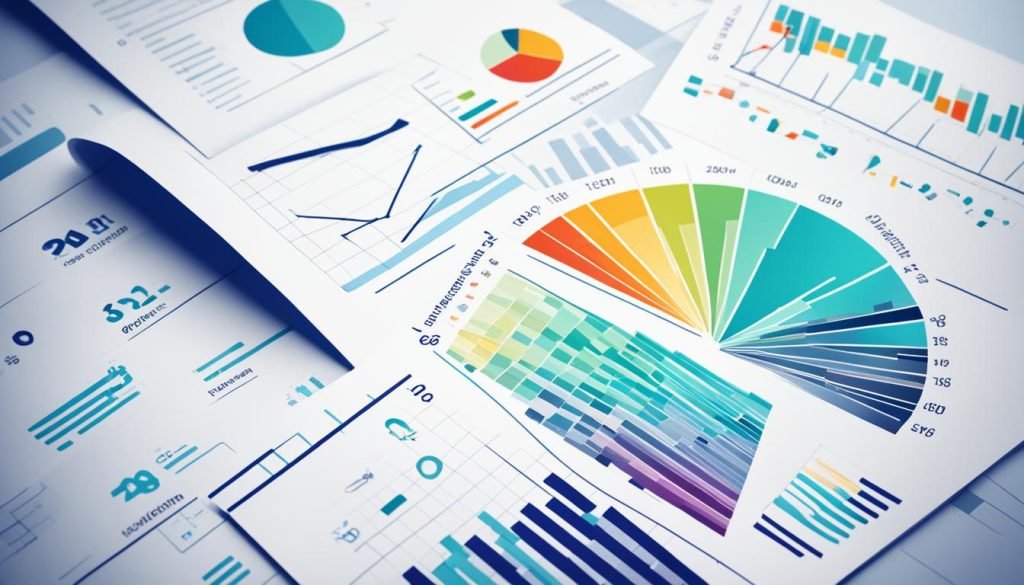Welcome to our in-depth guide on economic trends analysis. Here, we’ll dive into the importance of understanding economic indicators, analyzing market trends, and forecasting future shifts. This knowledge allows businesses to strategize and seize new chances.
Studying economic trends means looking closely at different indicators. This helps to find patterns that can affect companies and industries. From analyzing markets to forecasting, this approach unveils the economy’s current status.
Thorough economic data analysis lets businesses make choices that support growth and reduce risks. We’ll explore the power of economic trends analysis in helping businesses lead in today’s competitive market.
Key Takeaways:
- Economic trends analysis helps businesses understand market shifts and identify opportunities for growth.
- By analyzing economic indicators and data, businesses can make informed decisions about their strategies and investments.
- Market analysis and economic forecasting provide valuable insights into the current state of the economy and future possibilities.
- Thorough research and analysis help businesses minimize risks, enhance competitiveness, and drive growth.
- Understanding economic trends empowers businesses to adapt to the evolving economic landscape and seize opportunities.
Importance of Understanding Industry Trends for Business Success
Staying ahead in business means knowing the latest industry trends. These trends cover many areas, like tech, what people want, and rules. Knowing these helps companies make smart choices and keep up.
Looking at data is key to seeing what’s coming. Businesses use info on markets, what customers do, and what sells to spot trends. Techniques like digging deep into data, sorting customers, and checking market sizes are really helpful.
Keeping an eye on what rivals do also reveals trends. Watching what competitors launch or how they market their stuff helps. It shows where the market’s headed and where a business could stand out by offering something new.
Listening to experts is another good move. They share in-depth insights and predictions because they really know their stuff. Using their views helps businesses figure out what’s next in the industry. It guides them to make choices that match where the market’s moving.
Analyzing Data: Uncovering Hidden Trends
Using data to understand trends is super important. By sifting through lots of data, companies find useful trends. This lets them make choices with more certainty, thanks to spotting patterns and changes early.
“Data analysis lets companies use raw data to get ahead. By looking at what customers do and how markets change, companies can make choices that beat the competition.” – Jane Smith, Data Analyst
Gathering Competitor Insights: Staying Competitive
Keeping an eye on what competitors do is crucial. By watching their moves, businesses can see what’s picking up. A good knowledge of your competition helps in adapting to what customers are looking for. It means improving your own strategies to do better.
Consulting Expert Reports: Leveraging Industry Knowledge
Reports from experts give a deep look at what’s going on. When companies read these, they better understand the industry. It helps to know what people prefer, how markets move, and new tech. This lets businesses plan ahead and stay in line with trends.
Knowing industry trends well is essential for businesses to succeed and grow. By looking at data, keeping tabs on rivals, and listening to experts, companies can move in the right direction. This prepares them for what’s to come, and how to stand out.
Leading, Lagging, and Coincident Economic Indicators
Economic indicators are key for understanding the economy. They give clues about its future. There are three main types of economic indicators: leading, lagging, and coincident.
Leading Indicators
Leading indicators are very important. They’re looked at by economists, investors, and business leaders. Why? Because they hint at where the economy is headed. Examples include:
- Market indexes: like the S&P 500 or Dow Jones, show the stock market’s overall health.
- Unemployment insurance claims: less initial claims suggest more jobs and possibly a growing economy.
- Money supply: more money in the system can boost economic activity and inflation.
- New residential construction (housing starts): more building means people are more confident, and the economy is likely growing.
- Existing home sales: increasing home sales show a strong housing market and happy consumers.
- Gross Domestic Product (GDP): GDP tracks a country’s total economic output.
- Consumer Confidence Index: this measures how optimistic people are about the economy and their spending.
Lagging Indicators
Lagging indicators come in after the fact. They solidify what’s already happened in the economy. Yet, they can also hint at the future. Examples of lagging indicators are:
- Unemployment rate: a high rate signals past economic struggles. A low rate means strength and maybe upcoming inflation.
- Corporate profits: more profit shows the economy has expanded. Losses can show a downturn may be coming.
- Interest rates: shifts in interest rates affect how much it costs to borrow, as well as inflation and spending.
- Inflation rate: it showcases past growth. Low inflation might mean an economic slowdown.
Coincident Indicators
Coincident indicators show today’s economy. They give us a current economic picture. Examples include:
- Industrial production: shows how much manufacturing, mining, and utilities are producing.
- Retail sales: indicates how much money consumers are spending on things.
- Employment levels: tells us how many people are working.
- Personal income: covers everyone’s earnings from all sources.
For policymakers and business people, these economic indicators are crucial. They guide decisions about the economy, investments, and business plans. By keeping an eye on these indicators, they can understand trends, predict market changes, and plan for success.
Importance of Market Indexes and Other Key Indicators
Market indexes, like the stock market, are very important. They give us hints about where the economy might go. They are key for investors and can show us future trends.
Leading economic indicators can forecast what’s coming. They include things like stock futures and mortgage rates. These help investors make smart choices with their money.
There are also important reports to keep an eye on. This could be anything from Unemployment Claims to Consumer Confidence. Looking at these can give a clear picture of how the economy is doing.
By watching these indexes and indicators, investors can spot new trends early. This helps in making plans to avoid risks and adjust strategies. They are crucial for understanding the economy and making wise investment moves.
Market Indexes and Key Indicators Overview
| Market Indexes | Key Indicators |
|---|---|
|
|

The table above shows top market indexes and indicators. They guide policymakers and investors on the economy’s health. Knowing these helps make smart choices.
Looking at stock indexes or unemployment claims gives crucial data. This data helps with investment plans and economic strategies.
Keeping up with these indexes is vital for investors. It helps them find chances, handle risks, and adapt to the economy’s changes.
Methods for Identifying and Analyzing Industry Trends
There are many methods to find industry trends. These help businesses make smart choices leading to success.
Data Analysis and Market Research
Data analysis and research are key. They offer insights into what customers like and what competitors do. With data mining, companies find valuable info in big data sets, spotting patterns and new trends.
Segmenting customers, sizing up markets, and checking growth rates are valuable steps. They help find out more about industry trends.
Gaining Competitive Insights
Watching competitors can show changing industry trends. Knowing what they offer and how they market, helps. It reveals new niches and areas for innovation.
Customer Feedback and Industry Experts
Listening to customers and experts is crucial. Customers tell what they want and need now. Meanwhile, experts predict future trends.
Talking to both keeps a business up-to-date and ahead of the competition.
Analyst Reports, Government Resources, and Trade Publications
Reports from analysts, government data, and trade articles are solid info sources. They provide research, news, and insider views. Using these helps businesses make smart, up-to-date decisions.
Attending Industry Events and Using Data Analytics Tools
Going to industry events helps with networking and seeing new products. They’re where the newest trends often appear. Plus, analytical tools can spot trends in data quickly.
Social Media Listening Tools and Industry Forums
Using social media tools provides insights into what people are saying online. It reveals immediate trends and customer views. Forums also offer trends, shared by industry members.
Using the above methods gives companies a full view of the market. It helps them make choices that fit the changing industry.

Conclusion
Economic trends are key to understanding shifts in the market. They help companies spot chances for success. By looking at economic signs and data, businesses can make smart choices. This includes where to invest and what strategies to use.
It is important for businesses to understand industry trends. This helps them react well to market changes. It also lets them predict what customers will want. Doing this well can give them an edge over competitors. By staying up to date on economic indicators, analyzing data, and tracking trends, businesses position themselves for victory. They can adjust to any economic changes easily.
Understanding the bigger picture of the economy is also key. It helps businesses make wise decisions and grow. The right economic data can help companies know when to act. They can watch how markets change, see what consumers do, and understand global issues.
Being on top of economic trends lets businesses find new customers. They can change what they offer to meet wants. This helps them use their resources well. Such knowledge helps businesses stay strong in their field and succeed in the long run.
Industry trends and economic signs together offer a deep look at business environments. They show where growth might happen. Companies that keep an eye on these trends can prepare for what’s next. They can find new markets and grow with changing trends.
Staying ahead with these insights allows companies to innovate. This keeps them competitive in a fast-paced market. By combining economic and industry analyses, companies can be leaders. They can take advantage of the many chances in a changing business world.



